A Complete Guide to Addressable LED Strips
Table of Contents
Due to their easy installation, high energy efficiency, and low maintenance requirements, LED strips are widely used in various industries, including furniture, automotive, advertising, lighting, boats, bars, and more. When a dynamic lighting solution is needed, LED strips become an excellent choice. These strips come in a variety of colors, such as red, green, blue, RGB, etc., and can be installed almost anywhere. Searching for alternative lighting solutions that can rival the versatility of LED strips is highly challenging.
Taking the benchmark to a new level, addressable LED strips offer more options and impressive lighting effects like running chases, flowing fades, meteor trails, and much more. You can even design your customized lighting effects with a control system. However, the key lies in selecting the appropriate addressable LED strip, which may seem daunting if you are unfamiliar with the process. There’s no need to worry if you are unsure about choosing the right addressable LED strip. Keep reading to discover all the essential information you need to know about addressable LED strips.

What Is An Addressable LED Strip?
An addressable LED strip, also known as a digital LED strip, pixel LED strip, magic LED strip, or dream color LED strip, refers to a type of LED strip that incorporates control ICs. These ICs enable you to control individual LEDs or clusters of LEDs. With an addressable LED strip, you can control specific sections or segments of the strip, which is why it is referred to as “addressable.”
Addressable vs. Analog LED Strips: Key Differences
Analog LED strips enable you to have a single color for the entire strip at any given time. You can change the color for the entire strip whenever desired, but it’s impossible to alter the color for individual LEDs. On the other hand, addressable LED strips offer the capability to have different colors for each section of LEDs, resulting in a diverse range of colors across various areas of a single LED strip.
Functioning of Addressable LED Strips
Addressable LED strips operate by harnessing the combined functionality of five key components. These components collaborate harmoniously to ensure the seamless operation of the strip. The fundamental constituents are as follows:
- Light-emitting diodes (LEDs): The LEDs are the illuminating elements of the strip, responsible for producing vibrant and colorful light. They are arranged sequentially and emit light when an electric current flows through them.
- Integrated circuit chips (ICs): These tiny electronic chips act as the brains of the addressable LED strip. Each IC controls a specific section of LEDs, enabling individual control over color and brightness. By utilizing a communication protocol such as SPI (Serial Peripheral Interface) or WS2812, the ICs receive instructions from the controller and relay them to the respective LEDs.
- FPCB (Flexible Print Circuit Board): The FPCB is the foundation for the LEDs and ICs, providing a flexible and durable platform. It acts as a conduit, facilitating the flow of electrical signals between the components. The FPCB is designed to be easily bent or cut, allowing for customization and adaptation to different installations.
- Power supply: A power supply unit is employed to ensure the addressable LED strip receives the necessary electrical energy. The power supply converts standard AC or DC power into a suitable form for operating LEDs. It provides the required voltage and current to power the LEDs and ICs, enabling seamless operation.
- Controller: The controller interfaces the user and the addressable LED strip. It transmits commands and data to the ICs, enabling precise control over the strip’s behavior. Users can adjust parameters such as color, brightness, and dynamic lighting effects through the controller, which communicates with the ICs via a compatible communication protocol.
By synergistically utilizing these components, addressable LED strips deliver captivating and dynamic lighting displays, making them popular for various applications such as architectural lighting, interior design, and entertainment purposes.

Each cluster of LEDs is equipped with an integrated circuit chip that regulates the color and brightness variations within that cluster. This integrated circuit chip enables individual control over specific groups of LEDs. Unlike conventional RGB controllers, the controllers used to manage addressable LED strips possess unique features, such as a data channel and, in some cases, even a clock channel. In contrast, traditional RGB controllers typically have separate pins (R, G, B, and +) corresponding to the RGB strips.
The operational sequence of addressable LED strips can be summarized as follows:
- The current flows through the LEDs upon powering on, causing them to illuminate according to their default settings.
- To generate a desired effect, you must input a command into the controller, which governs the color and brightness adjustments for a particular group of LEDs.
- The controller subsequently transmits the appropriate signals to the integrated circuit chips embedded within these LEDs. These chips execute the received command, thereby controlling the color and brightness changes of the LEDs.
How are addressable LED strips utilized?
Addressable LED strips serve multiple purposes and can be employed in various settings. Some typical applications include:
- Decorative Lighting: Addressable LED strips are famous for enhancing the aesthetics of different spaces. They are frequently used in KTVs, bars, gyms, and venues to create beautiful lighting displays.
- Building Facades Lighting: Addressable LED strips are an ideal choice for illuminating the exteriors of tall buildings, bridges, and other architectural structures. They add a visually appealing element to the surroundings and can be programmed to create dynamic lighting effects.
- Special Event Lighting: Addressable LED strips are highly versatile and can enhance the ambiance of special events. Whether it’s Christmas, concerts, or other celebrations, these LED strips can be utilized creatively to generate beautiful lighting arrangements.
- Home Lighting: Addressable LED strips are also famous for home lighting applications. They provide an opportunity to personalize and embellish the living space. Whether used to decorate specific areas or to create a cozy and festive atmosphere, addressable LED strips are a great addition to any home environment.

What types of addressable LED strips are available?
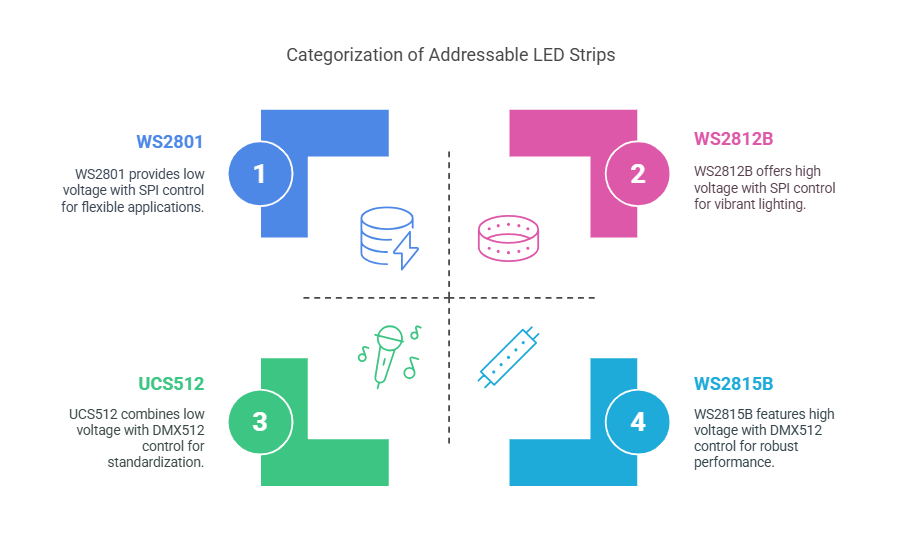
Addressable LED strips can be classified into two primary categories: DMX512 and SPI addressable LED strips.
The DMX512 addressable LED strip
Utilizes the power of digital multiplexing to control its lighting effects. With DMX512, 512 individual channels can be digitally manipulated through a single data cable. This standardized protocol revolutionized stage lighting and effects control, replacing the previously fragmented landscape of incompatible proprietary protocols used to operate lighting dimmers. Today, DMX512 is widely adopted as the go-to method for achieving synchronized and versatile control over lighting systems.
The DMX512 addressable LED strip is designed to directly receive DMX512 signals, eliminating the need for a separate DMX512 decoder. This strip effectively adjusts the color and brightness of the light based on the received signal.

Addressable LED strip with SPI interface
The SPI interface, short for Serial Peripheral Interface, is a widely used synchronous serial communication specification primarily employed in embedded systems for short-distance communication. Initially developed by Motorola in the mid-1980s, it has become a de facto standard. This interface finds applications in various devices, including Secure Digital cards and liquid crystal displays.
The SPI addressable LED strip is specifically designed to receive SPI signals, enabling it to effortlessly change the color and brightness of the light in response to the received signal.
DMX512 vs. SPI: Key Differences and Comparison
DMX512 is a globally accepted standard protocol, whereas SPI protocol is subject to alterations based on each integrated circuit (IC) manufacturer.
Communication Protocol :
DMX512 employs a parallel, synchronous parallel interface for signal transmission, making it a universal control protocol for digital lighting equipment. On the other hand, SPI utilizes a serial (synchronous serial interface) approach for signal transmission.
Compatibility:
DMX512 boasts full compatibility due to its unified IC class/protocol and usage in certain lighting fixtures. SPI’s compatibility is less remarkable, given the variety of IC types and slightly varied protocols, with virtually no luminaires using SPI.
Reliability:
DMX512, with its breakpoint transmission and parallel signal delivery, offers high reliability. SPI also uses breakpoint transmission but cannot renew transmission following two consecutive breakpoints.
Wiring Complexity:
Wiring DMX512 tends to be more intricate. Conversely, SPI provides a more straightforward wiring process.
Signal Interference Resistance:
DMX512 excels in resisting signal interference, demonstrating strong capability for long-distance communication even in interference. SPI performs less admirably in this regard, with long-distance communication vulnerable to high current or magnetic solid disturbances.
Cost Analysis:
DMX512 carries a higher overall cost, while SPI is a more budget-friendly option.
Use Cases:
DMX512 is typically used in indoor and outdoor large to ultra-large advertising lighting and for synchronized control of light shows. SPI suits smaller spaces, independent designs, and auxiliary facilities.
Tips for Choosing the Right Addressable LED Strip
When selecting an addressable LED strip, it’s essential to consider specific parameters impacting its performance. Here are some key factors to keep in mind:
- Voltage: Addressable LED strips are typically available in 5V, 12V, and 24V options. In general, a higher voltage is preferable. The reason behind this lies in the concept of voltage drop.
- Understanding Voltage Drop: Voltage drop refers to the decrease in voltage that an LED strip experiences as its length increases. The LEDs near the power source will appear brighter, while the LEDs at the end of the strip may appear dimmer.
- Causes of Voltage Drop: Every wire has a certain amount of electrical resistance, which increases with the length of the wire. This electrical resistance leads to voltage drop, reducing the LEDs’ brightness.
- Consequently, LEDs at the end of a strip receive less voltage than those at the beginning. As the strip lengthens, the voltage drop becomes more significant, leading to noticeable differences in brightness.
- Solving the Voltage Drop Issue: It’s worth noting that not all addressable LED strips come in high-voltage variants such as 24V or 12V. However, you can address the voltage drop problem by connecting both ends of the LED strip to the power supply. This ensures a more consistent voltage distribution along the entire length of the strip.
- By considering the voltage and voltage drop and addressing the issue appropriately, you can choose the right addressable LED strip for your needs.
- Power Usage: The brightness of the LED strip increases with higher power consumption. The power consumption you select will depend on the desired level of brightness.
- Color Type:
The addressable LED strip offers a diverse selection of colors.
Single Colors: White, Warm White, Red, Green, Blue, Yellow, Pink, and more.
Dual Color: White + Warm White, Red + Blue.
RGB
RGB + White
RGB + Warm White + White
Classification of Integrated Circuit Chips (ICs)
DMX512 functions as a global standard protocol. While performance can differ among various DMX512 ICs, they all adhere to the same protocols. This uniformity enables a single DMX512 controller to manage distinct types of DMX512 ICs. On the other hand, SPI isn’t recognized as a global standard protocol. SPI ICs, when produced by diverse manufacturers, are compatible with differing protocols. This distinction implies that specific SPI ICs might require different SPI controllers. Here’s a rundown of the prevalent IC models in the market:
DMX512 Controllable LED Strips: UCS512, SM17512
SPI controllable ICs can be categorized based on whether they are built-in or external, whether they possess a breakpoint resume transmission or lack it, and whether they include a clock channel.
Standard SPI Controllable LED Strip with Built-In IC models: WS2812B, WS2813, WS2815B, SK6812, SK9822, APA102, CS2803, CS8812B Common SPI Controllable LED Strip Models with External ICs: WS2801, WS2811, WS2818, UCS1903, TM1814, TM1914, TM1812, CS8208, CS6816, CS6814, LPD8806
What is the Breakpoint Resume Function of SPI Controllable LED Strips?
The breakpoint resume function refers to the ability of an IC to continue transmitting signals to subsequent ICs even if a single IC becomes defective.
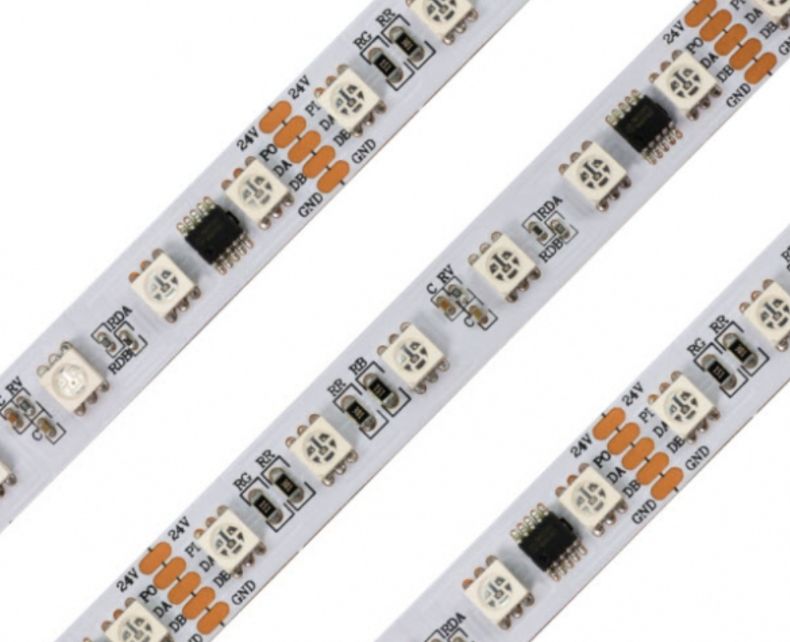
SPI Addressable LED strip IC models with breakpoint resume function:
- WS2813
- WS2815B
- CS2803
- CS8812B
- WS2818
- TM1914
- CS8208
SPI Addressable LED strip IC models without breakpoint resume function:
- WS2812B
- SK6812
- SK9822
- APA102
- WS2801
- WS2811
- UCS1903
- TM1814
- TM1812
- CS6816
- CS6814
- LPD8806
IC models with a clock channel:
- SK9822
- APA102
- WS2801
- LPD8806
IC models without a clock channel:
- WS2812B
- WS2813
- WS2815B
- SK6812
- CS2803
- CS8812B
- WS2811
- WS2818
- UCS1903
- TM1814
- TM1914
- TM1812
- CS8208
- CS6816
- CS6814
LED Strip Density
LED strip density refers to the number of LEDs per meter of addressable LED strips. A higher LED density results in more uniform lighting and increased brightness and eliminates any light spots.
IP Rating
The IP Code, also known as the Ingress Protection Code, is defined in IEC 60529. It categorizes and rates the level of protection provided by mechanical enclosures and electrical casings against intrusion, dust, accidental contact, and water. CENELEC publishes the IP Code as EN 60529 in the European Union.
For outdoor installations of addressable LED strips, it is recommended to use IP65 or a higher IP-rated addressable LED strip. However, if the installation involves submersion in water for short periods, it is safer to use IP67 or even IP68-rated strips.
Wiring Addressable LED Strips
To control DMX512 addressable LED strips, you first need to utilize the “address writer” tool provided by the IC manufacturer. This tool allows you to set the DMX512 address into the DMX512 ICs. The address must only be set once, as the DMX512 IC will retain the data even if the power is turned off. Please refer to the accompanying photo for detailed instructions on setting the DMX512 address.

But, the SPI addressable led strip does not need to set the address before use.
SPI addressable led strips will have different outlets wired according to different functions, and their wiring diagrams will also differ.
Addressable led strip without breakpoint resume function only has data channel.
The addressable led strip with the resemble transmission function will have data and spare data channels.
Addressable led strips with clock channel functions have a data channel and a clock channel.
The data channel is generally represented by the letter D on the PCB, the spare data channel is represented by the letter B, and the clock channel is represented by the letter C.
SPI built-in IC addressable led strip
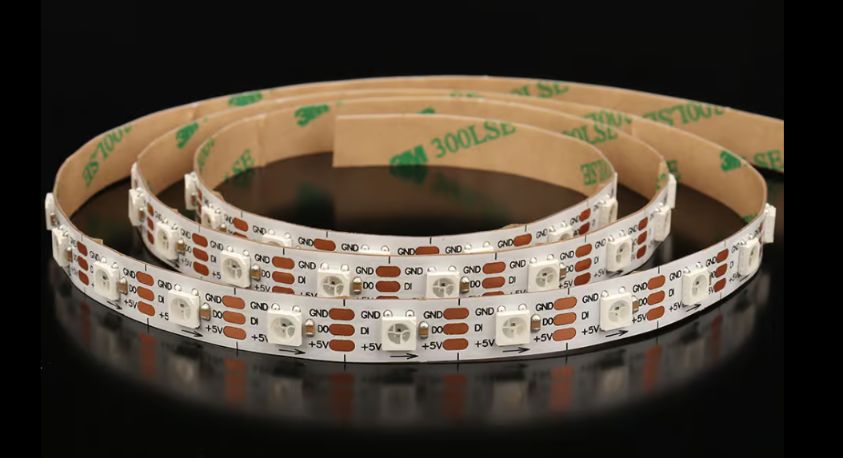
Addressable LED strips that can be controlled through an SPI external IC.
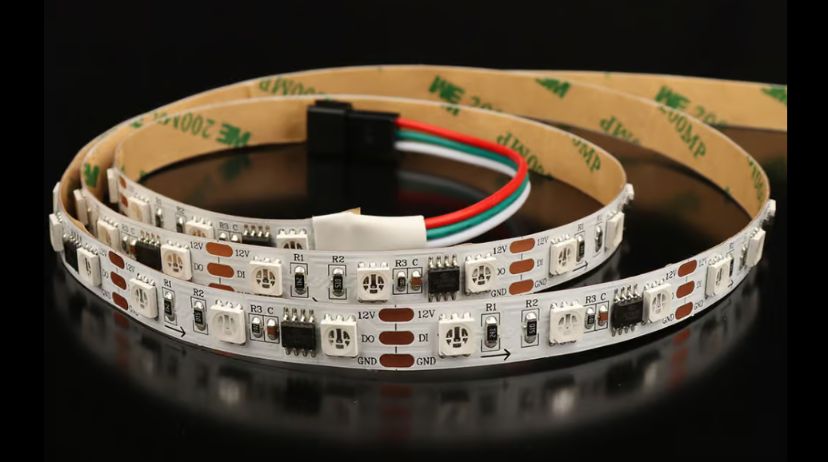
Addressable LED strips can be controlled through the SPI IC clock channel.
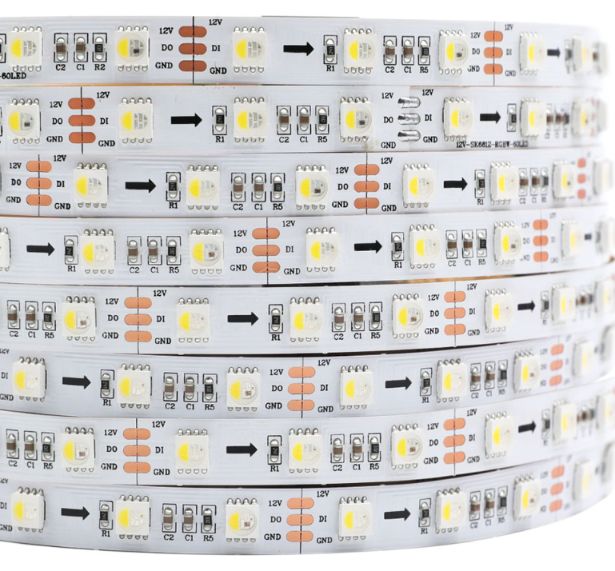
The SPI IC addressable LED strip operates seamlessly and utilizes the break, resume, and transmission functions.
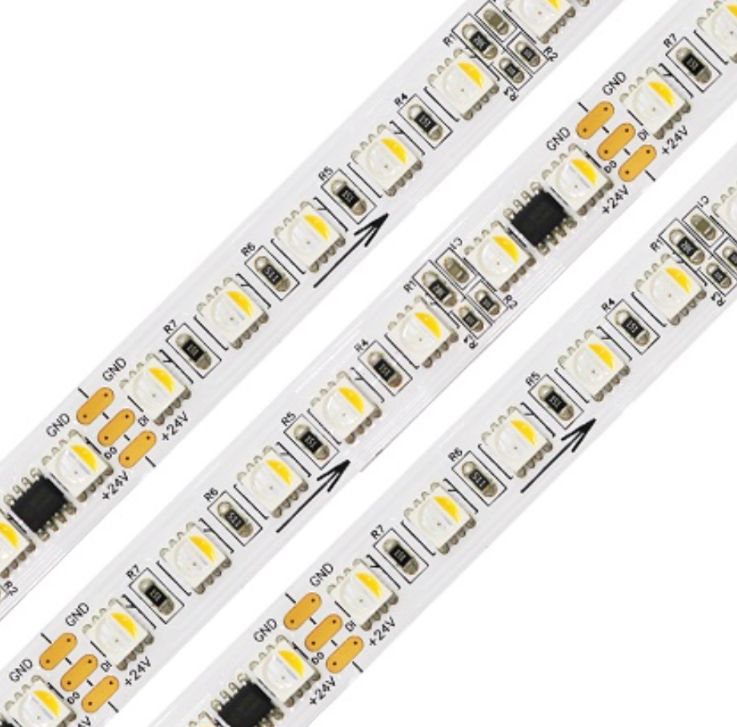
Discover the Wiring Diagram for Addressable LED Strips using DMX512

Wiring diagram for an SPI addressable LED strip with only a data channel:

Addressable LED strip with SPI interface featuring a data channel and clock channel
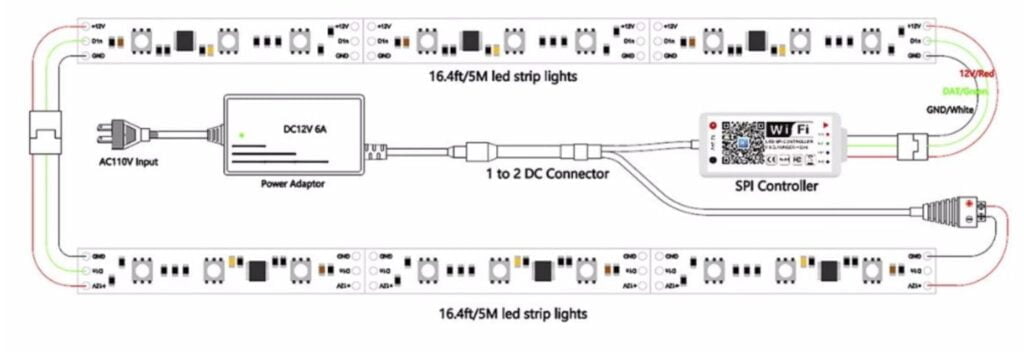
Addressable LED strip with a single data channel and a break/resume channel compatible with SPI.
Controlling Addressable LED Strips
Addressable LED strips can be effectively controlled using a DMX512 controller or a DMX512 master.
Are you looking to personalize your lighting projects? Discover the art of customizing addressable LED strips!
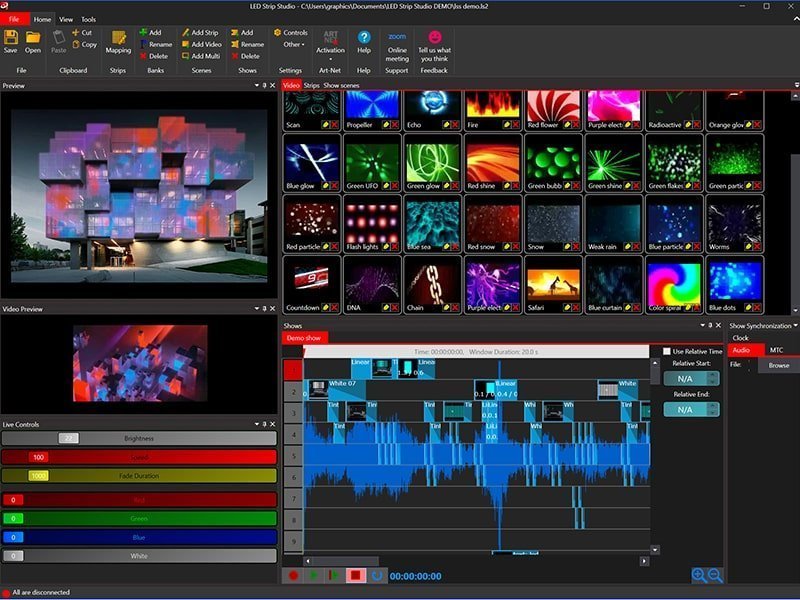
Step 1: Begin by clearly understanding the desired lighting effect and thoroughly defining your requirements. The more specific, the better. This will facilitate effective communication with Chinese LED strip manufacturers.
Step 2: Contact several Chinese LED strip manufacturers, informing them of your needs and ideally providing drawings that depict the size of the area, installation locations for the LED strips, and the desired lighting effect. To convey the lighting effect accurately, it’s recommended to search for examples on YouTube and share them with the manufacturer. They are better equipped to understand your requirements. In short, we aim to provide the LED strip manufacturer with as much detailed information as possible.
Step 3: Once the salesperson at the Chinese manufacturer has received your exact requirements, they will consult with the electrical engineer to determine the number of LED strips, controllers, and power supplies needed.
Step 4: The salesperson will then collaborate with a lighting designer or programmer to discuss implementing your lighting effect. This is typically done using platforms like LedEdit or Madrix. It’s important to note that not many LED strip manufacturers in China offer lighting design services, let alone programming based on Madrix software. Therefore, finding a Chinese LED manufacturer that can provide this programming service may require some patience.
Step 5: The salesperson will discuss further with you to finalize specific details and provide a price quote. After confirming the details back and forth, you can proceed to place the order with the Chinese LED strip manufacturer.
Step 6: The manufacturer will ship the entire order to you once the production is complete.
Step 7: You must hire experts or electricians to install the customized LED strips. As all calculations are based on the provided project site information, the LED strip manufacturer in China will usually design and provide you with a wiring diagram for the installation. Therefore, follow the instructions provided to complete the installation successfully.
Step 8: Carry out the installation and lighting commissioning. It’s important to note that only a few LED strip manufacturers in China offer on-site services where their field engineers come to your location to complete the entire installation process.
Looking for a Place to Purchase Addressable LED Strips?
Regarding addressable LED strips, they tend to be more intricate than regular LED strips. Consequently, selecting the appropriate addressable LED strip manufacturer can be more challenging. Here are a few avenues through which you can locate a reliable addressable LED strip manufacturer:
- Alibaba
- Amazon
- Website
Conclusion
Having gone through this article, I trust that you now understand addressable LED strips and are equipped with the knowledge to select the appropriate one for your needs. For top-quality LED strip lights, LED tape lights, and LED neon lights, consider MyLikeLed, a renowned manufacturer based in China. We specialize in providing customized solutions, as well as offering OEM and ODM services. We welcome wholesalers, distributors, dealers, traders, and agents to make bulk purchases with us.
FAQs
What is the advantage of using an addressable LED strip?
The main advantage of using an addressable LED strip is the ability to control each LED or group of LEDs individually. This allows for more dynamic lighting effects, such as color-changing patterns, gradients, or animations, which aren’t possible with regular LED strips.
Can I connect multiple addressable LED strips together?
Yes, you can connect multiple addressable LED strips together, as long as the controller supports the number of LEDs you intend to use. It’s important to make sure the power supply can handle the combined wattage of all the strips to ensure proper operation.
What types of controllers are compatible with addressable LED strips?
Addressable LED strips typically require a DMX, SPI, or specialized controller for control. These controllers send the necessary data to the LED strip to adjust the color, brightness, and effects for each individual LED or segment.
Can addressable LED strips display multiple colors at once?
Yes, addressable LED strips can display multiple colors simultaneously along the strip. Since each LED is individually controlled, it allows for different sections of the strip to display different colors or lighting effects at the same time.
How do I power addressable LED strips?
Addressable LED strips need a stable power source that matches their voltage requirement (commonly 12V or 24V). Additionally, a power supply with enough wattage is essential to support the total number of LEDs, especially when using multiple strips or higher brightness settings.

Hi, I’m Xylia Xiong, a sales professional with 14 years of experience in the LED strip light industry. I specialize in providing tailored solutions, leveraging my expertise in LED products and the latest industry trends. Known for effective communication and problem-solving, I’m dedicated to helping lighting manufacturers, importers, and distributors achieve their goals.
Let’s work together to create customized solutions that exceed expectations.
Related Posts

The Best LED Strip Lights You Can Buy Right Now

Comparing WS2811 Vs WS2812B: Key Differences


